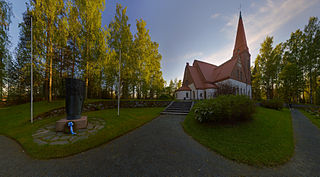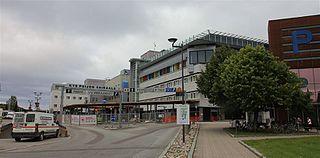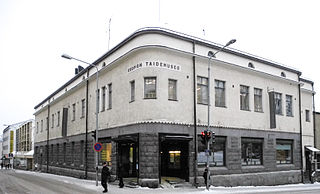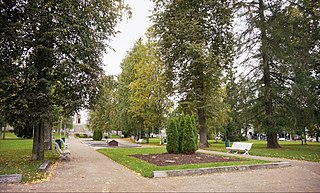
Siilinjärvi is a municipality of Finland. It is located in Northern Savonia, 20 kilometres (12 mi) north of the city of Kuopio, which largely surrounds Siilinjärvi. Another neighbour municipality with Kuopio is Lapinlahti. The name, in Finnish, apparently translates literally as "Hedgehog's Lake", although its etymology actually stems from a Sámi word meaning winter dwelling. Lakes are essential part of the geography of Siilinjärvi. There are 123 lakes, and the biggest of them are Kallavesi and Juurusvesi–Akonvesi. Water area is 106.85 km2, which is 21% of the whole area of Siilinjärvi.

Hämeenlinna is a city and municipality of about 68,000 inhabitants in the heart of the historical province of Tavastia and the modern province of Kanta-Häme in the south of Finland. Hämeenlinna is the oldest inland city of Finland and was one of the most important Finnish cities until the 19th century. It still remains an important regional center. The medieval Häme Castle is located in the city.

Kuopio is a Finnish city and municipality located in the region of Northern Savonia (Pohjois-Savo). It has a population of 121,557, which makes it the 8th most populous city in Finland and the most populous city in Eastern Finland Province. At the end of 2018, the population of the city center of Kuopio was 89,307. Kuopio has a total area of 4,326.35 square kilometres (1,670.41 sq mi), of which 719.85 km2 (277.94 sq mi) is water and half is forest. Though the city's population is a spread-out 76/km2 (200/sq mi), the city's urban areas are populated comparably densely, making Kuopio Finland's second-most densely populated city. Along with the city of Joensuu, Kuopio is one of the major urban, economic, and cultural hubs of Eastern Finland.

Maaninka is a former municipality in the region of Northern Savonia, in Finland. It was merged with the city of Kuopio on 1 January 2015.

Niirala is a district in the city of Kuopio, Finland, and it has a population of about 3,500. Niirala is now a popular residential area due to its good location between the Kuopio University and the city center. Niirala's main street is Niiralankatu. The neighboring parts of Niirala are Hatsala in the northeast, Haapaniemi in the southeast, and Savilahti in the west.

Väinölänniemi is a district in the city of Kuopio, Finland. It is more commonly known for the Väinölänniemi Peninsula, located in this district and surrounded by Kallavesi, with its beaches, sports fields and park areas.

Puijonlaakso is a district in the city of Kuopio, Finland. As the name implies, it is located right next to Puijo Hill and is a very green area. The area has about 6,400 inhabitants, many of whom are students.

Männistö is a district in the city of Kuopio, Finland It is part of the Itkonniemi–Männistö–Linnanpelto division area, which has a population of just over 5,800.

Julkula is a district in the northwest part of the city of Kuopio, Finland. It is located 4-6 km from the city center on the western slope of Puijo. The area has a population of about 2,700 and its residential buildings are mainly small and terraced houses.

Kuopio Market Square is the market square in the Multimäki district in Kuopio, North Savonia, Finland. The market is located about one hundred meters above sea level and the size of the area is 130×174 meters. The cover is made of dice and nubile stone. In the east–west direction, the area is crossed by flat walkways. As a surface, the market is slightly sloping, which poses challenges for use. The structure rests on a 10–15 m deep sand mattress, under which there is a ridge formation starting from Väinölänniemi, which runs under the church towards Puijo. Tulliportinkatu runs along the edges of the square in the north, Puijonkatu in the east, Kauppakatu in the south and Haapaniemenkatu in the west.

Rönö is an island in Lake Kallavesi and also a district in the city of Kuopio, Finland. It is located about 2,5 kilometers southeast of Kuopio Market Square, measured along the street network. Since 1988, the island has been connected to Väinölänniemi by a bridge. Rönö is a sought-after residential area and is one of the most expensive areas in Kuopio, along with the archipelago estates in Saaristokaupunki. Only detached, semi-detached and terraced houses have been built there. Most of the island was built during the boom of art in the 1980s and 1990s, but houses have also been built in the 2000s, and a few estates are still completely undeveloped. By the decision of the city council, tenant houses were once built on the highest point of Rönö.

Multimäki is a central district in the heart of Kuopio, Finland. Many of Kuopio's most significant attractions, including the Kuopio's Market Square and Market Hall, Heroes' Park and the Kuopio City Hall, are located in the district. Kuopio Lyceum High School and two kindergartens also operate in the district. Multimäki borders district of Maljalahti in the north, Vahtivuori in the east, Kuopionlahti in the south, and Hatsala in the west. The boundaries of the district are street Minna Canthin katu in the south, Vuorikatu in the east, Suokatu in the north and Puistokatu in the west.

Puijo is a district of Kuopio, Finland. It is located north of the center of Kuopio, along the European route E63. The area includes, among other things, Puijo Hill with its nature reserves, and the Great Cemetery of Kuopio on the south side of the hill between the five roads and the railroad track. There are many exercise and sports venues in the district.

Tampere Market Hall is one of the significant market places in Tampere, Finland. It is located in the center of city, between Hämeenkatu and Hallituskatu, and it was opened in 1901. It was decided to build the market in Tampere as a result of a large and unregulated market. It is the largest market hall in the Nordic countries.

Vahtivuori is a district in the city of Kuopio, Finland, located between the city center and Lake Kallavesi. The southern boundary of Vahtivuori is Minna Canthin katu, the western boundary is Vuorikatu, the northern boundary is Suokatu and the eastern boundary is formed by Lake Kallavesi. The neighboring parts of Vahtivuori are Maljalahti in the north, Väinölänniemi in the south and Multimäki in the west.

The Kuopio Governor Palace or State Provincial Office of Kuopio is a former government building in Kuopio, Finland, located in the Väinölänniemi district on the Hallituskatu street in the immediate vicinity of Kuopionlahti and Väinölänniemi parks. It was designed by architect Konstantin Kiseleff, who completed the building plan in 1882. The staff of the Administrative Board of the Kuopio Province moved into the building in 1885. It represents the architectural style of the Neo-Renaissance. The building is fully protected from both the outside and inside. The building is owned by the state-owned company Senate Properties and houses the office of the Regional State Administrative Agency for Eastern Finland.

Pirtti is a district of Kuopio, Finland. It belongs to the larger subdivision of Petonen, and it is located about 10 kilometers from the center of Kuopio. At the beginning of 2015, the district had a population of 5,480.

The Matkus Shopping Center is a shopping mall in the southern part of Kuopio, Finland, located 11 kilometres (6.8 mi) south of its city center along the Highway 5 (E63), in the Matkus business area of the Hiltulanlahti district. It is the fifth largest business center in Finland. On bus lines 31 and 35 from the Kuopio Market Square directly to the shopping center.

Maljalahti is a district in the central part of the city of Kuopio, Finland. The northern boundary of the district is the Savonia railway, the Hatsalankatu street in the west, Suokatu in the south and Lake Kallavesi in the east. Neighboring parts of Maljalahti are Puijo and Linnanpelto in the north, Itkonniemi in the east, Vahtivuori and Multimäki in the south and Hatsala in the west.

The Snellman Park is the oldest park in the city of Kuopio, Finland, located at the Vahtivuori district in the city center between the Kauppakatu and Minna Canthin katu streets, in the adjacent block of Kuopio Cathedral. The park covers an area of 1.4 hectares. Today, the park and its surroundings are part of the larger Kuopio National City Park, established in late 2017. The park is named after J. V. Snellman (1806–1881), the senator and the Fennoman, who influenced the affairs of the Grand Duchy from Kuopio, among other places.





















